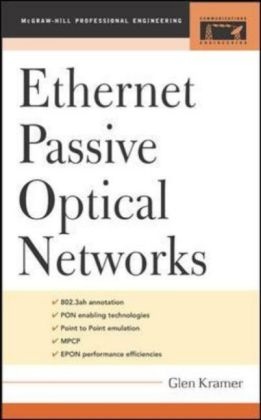Read more
Informationen zum Autor Glen Kramer, Ph.D. (Petaluma, CA) is a System Architect with Teknovus, Inc. He is an active and voting member of IEEE 802.3ah “Ethernet in the First Mile” task force and made numerous contributions to the IEEE 802 plenary and interim meetings. He was one of the lead authors of the Multi-Point Control Protocol (MPCP) that became a baseline protocol for EPON architecture. He is the founder of the EPON forums and has written more research publications on the topic than any other individual. He teaches EPON tutorials at conferences and workshops around the world. Klappentext Publisher's Note: Products purchased from Third Party sellers are not guaranteed by the publisher for quality, authenticity, or access to any online entitlements included with the product. THE DEFINITIVE GUIDE TO EPON Written by one of the authors of the IEEE802.3ah standard, this is the first book to fully explain the EPON architecture, analyze its performance, and annotate the standard. Clearly addressing efficiency, performance, and implementation issues, Ethernet Passive Optical Networks provides valuable, annotated insights into all engineering-critical EPON topics, including: PON enabling technologiesPoint-to-point emulationMulti-point control protocolError correctionPerformance analysisDiscovery optimizationsQuality of service in EPONFairness vs. efficiency There is no more expert or complete guide to understanding the performance and architectural complexities of EPON than Ethernet Passive Optical Networks. Inside Ethernet Passive Optical Networks: Part I: Overview of Access Network Architectures * Introduction * Overview of PON Enabling Technologies * Access Network Architectures Based on TDMA PON * Emergence of Ethernet PON Part II: EPON Architecture* EPON Overview * Logical Topology Emulation * Laser Control Function * Multi-Point Control Protocol: A Formal Specification * Forward Error CorrectionPart III: System-Level Issues * EPON Encryption Mechanism * Path Protection in EPON Part IV: EPON Performance Baseline Efficiency * Discovery Slot Allocation * EPON with Static Slot Assignment * EPON with Dynamic Slot Assignment * Support for Differentiated Classes of Service * Objectives of EPON Scheduling Algorithm * Cousin-Fair Hierarchical Scheduling in EPON * Conclusion Zusammenfassung Explains the EPON architecture! analyzes its performance! and annotates the standard. This book provides insights into various engineering-critical EPON topics! including: PON enabling technologies; point-to-point emulation; multi-point control protocol; error correction; performance analysis; and! discovery optimizations. Inhaltsverzeichnis PREFACEACKNOWLEDGMENTSPart 1: Overview of Access Network ArchitecturesChapter 1: IntroductionChapter 2: Overview of PON Enabling TechnologiesChapter 3: Access Network Architectures Based on TDMA PONChapter 4: Emergence of Ethernet PONPart 2: EPON ArchitectureChapter 5: EPON OverviewChapter 6: Logical Topology EmulationChapter 7: Laser Control FunctionChapter 8: Multi-Point Control Protocol: A Formal SpecificationChapter 9: Forward Error CorrectionPart 3: System-Level IssuesChapter 10: EPON EncryptionChapter 11: Path Protection in EPONPart 4: EPON PerformanceChapter 12: Baseline EfficiencyChapter 13: Discovery Slot AllocationChapter 14: EPON with Static Slot AssignmentChapter 15: EPON with Dynamic Slot AssignmentChapter 16: Support for Differential Classes of ServiceChapter 17: Objectives of EPON Scheduling AlgorithmChapter 18: Cousin-Fair Hierarchical Scheduling in EPONChapter 19: ConclusionAPPENDIX A: CHARACTERISTICS OF NETWORK TRAFFICAPPENDIX B: SYNTHETIC TRAFFIC GENERATIONBIBLIOGRAPHYINDEX...

